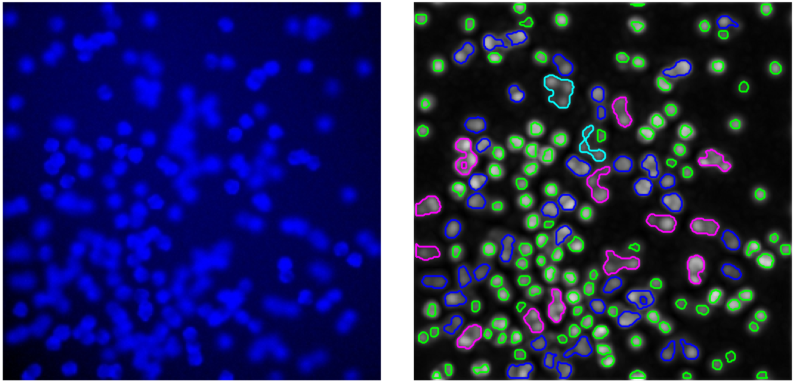Victor Lempitsky, an associate professor at Skoltech and head of Skoltech Computer Vision Group, and his colleagues Carlos Arteta, Alison Noble, and Andrew Zisserman from Oxford University have developed a new method for highly accurate detection of objects in microscopy images. Their work was published in Medical Image Analysis.
Object detection in microscopy images is a crucial step in many biological experiments, such as detection of cells, cell colonies and nuclei. This kind of analysis can be performed on its own to determine the presence and to count objects of interest (such as cancer cells in pathology images), but it can also serve as a starting point for further investigations (e.g. object segmentation or tracking).
Most computer vision methods used for understanding images with multiple overlapping objects fall into two classes. Methods that belong to the first class are based on individual object detection, while methods of the second class avoid the detection of individual instances but instead perform analysis based on local or global texture and appearance descriptors. The choice of the most appropriate method depends on the degree of overlap between objects and on object density. When object density is low and the overlaps between objects are infrequent, detection of individual objects can demonstrate higher performance than methods that belong to the second class (e.g. regression and density estimation). However, detection-based analysis fails when images have high object density and frequent overlap between objects. In such situations, performance of methods that belong to the second class (such as density/global count estimation) is better.

The result of the method (right) on the challenging fluorescence microscopy image (left): according to the method, green regions correspond to solitary cells, blue regions contain two-cell groups, magenta – three-cell groups, and cyan – five-cell groups.
Lempitsky and co-authors have developed an object detection method that demonstrates high accuracy in cases when microscopy images contain both high and low object density regions. They introduced a tree-structured discrete graphical model that is used to select and label a set of non-overlapping regions in the image by a global optimization of a classification score. The number of instances that are detected in the region determines the region’s label, so that later regions containing a specific number of instances can be selected. In the parts of images containing sparse cells, the method usually locates these individual cells, while for densely-populated parts containing overlapping objects, the method would locate groups of cells (and estimate the number of cells in each group). Such adaptive behavior guided by the optimization process is unique for this object detection method.
Moreover, the researchers have developed a pre-processing module that allows their method to handle particularly challenging scenarios, such as detection on noisy microscopy images. The model was evaluated over six data sets of images covering fluorescence microscopy, weak-fluorescence molecular images, phase contrast microscopy and histopathology images. It has been shown that the performance of the method developed be prof. Lempitsky and co-workers exceeds the state of the art.
- Arteta, V. Lempitsky, J. A. Noble, and A. Zisserman, “Detecting overlapping instances in microscopy images using extremal region trees,” Med. Image Anal., vol. 27, pp. 3–16, Jan. 2016.
* The Skolkovo Institute of Science and Technology (Skoltech) is a private graduate research university in Skolkovo, Russia, a suburb of Moscow. Established in 2011 in collaboration with MIT, Skoltech educates global leaders in innovation, advances scientific knowledge, and fosters new technologies to address critical issues facing Russia and the world. Applying international research and educational models, the university integrates the best Russian scientific traditions with twenty-first century entrepreneurship and innovation.
Contact information:
Skoltech Communications
+7 (495) 280 14 81
